上外版(2020)必修 第一册Unit 2 Language and CultureReading A 课件(共18张PPT)
文档属性
| 名称 | 上外版(2020)必修 第一册Unit 2 Language and CultureReading A 课件(共18张PPT) | 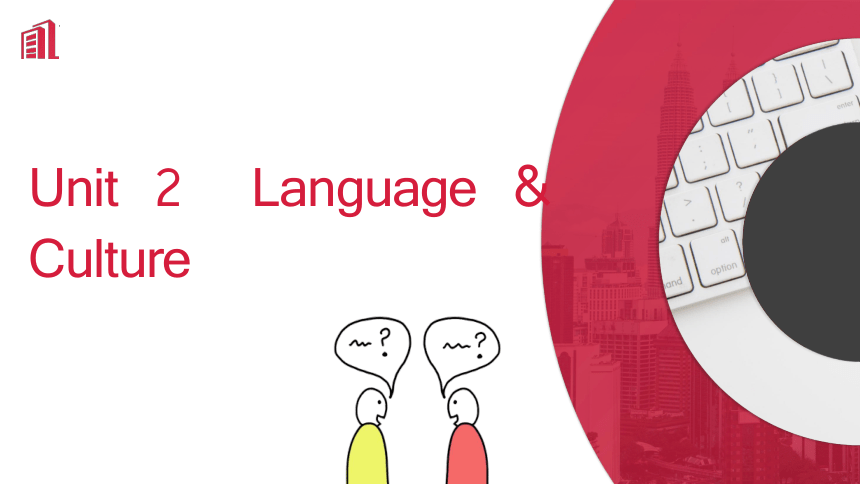 | |
| 格式 | pptx | ||
| 文件大小 | 6.7MB | ||
| 资源类型 | 教案 | ||
| 版本资源 | 上外版(2020) | ||
| 科目 | 英语 | ||
| 更新时间 | 2023-11-28 10:30:12 | ||
图片预览

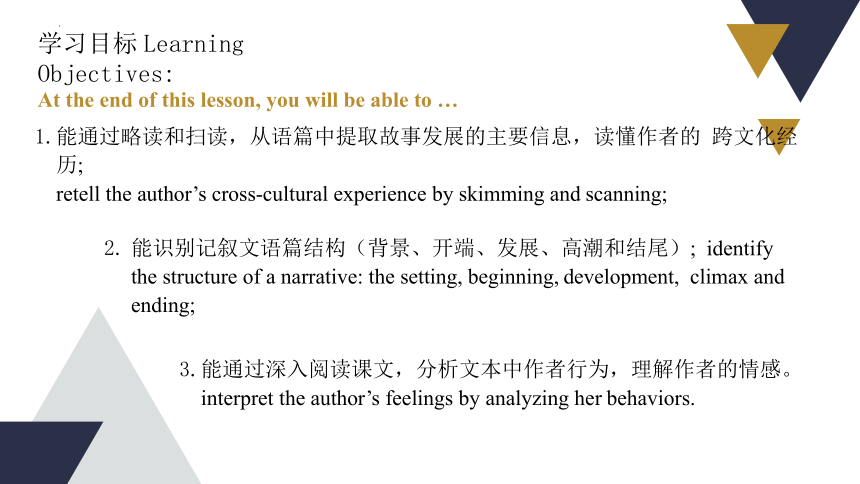

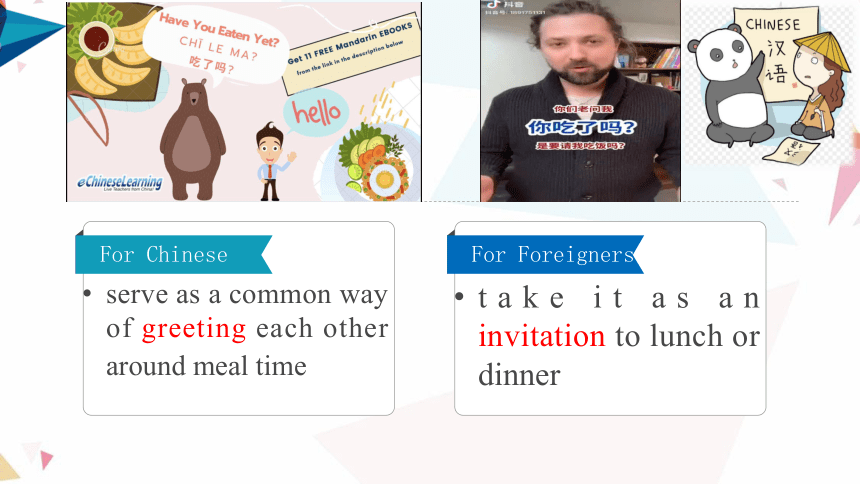
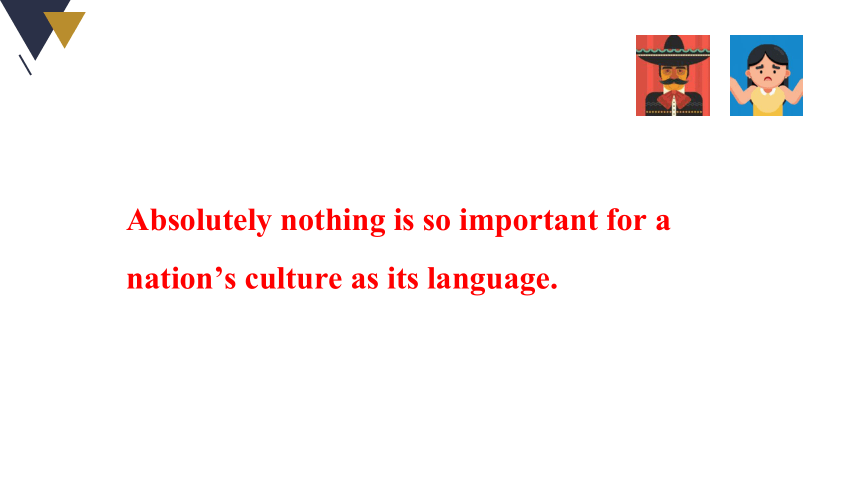
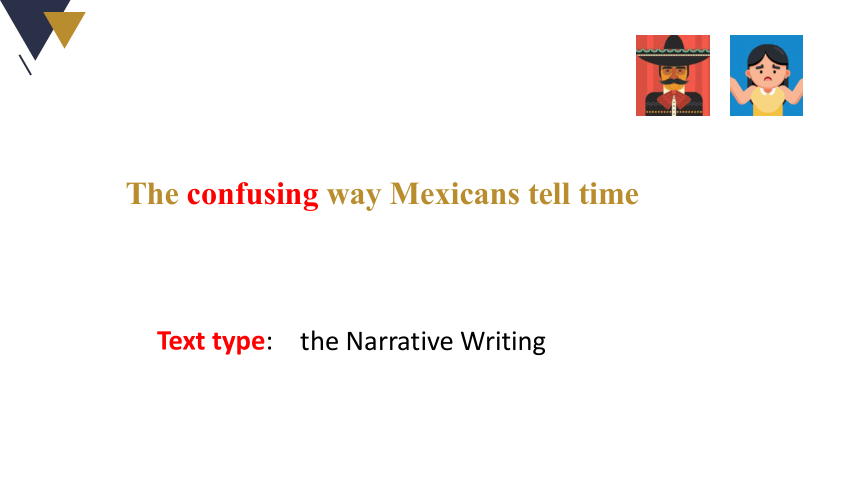
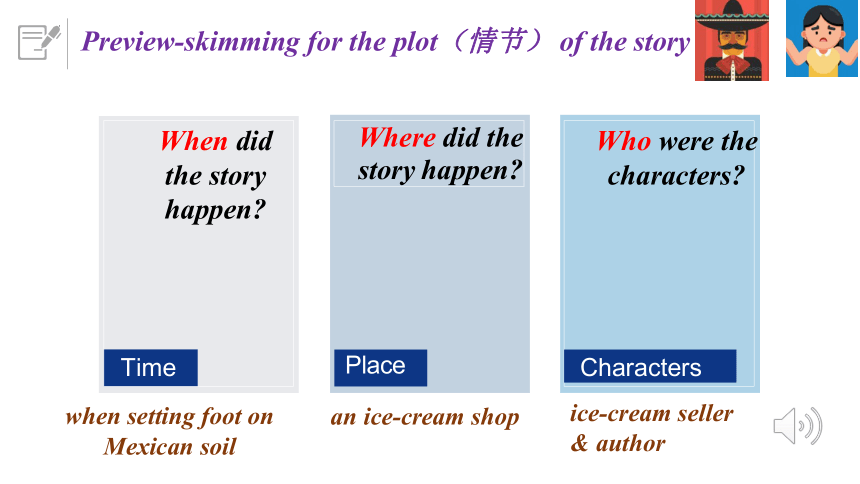
文档简介
(共18张PPT)
Unit 2 Language & Culture
学习目标 Learning Objectives:
At the end of this lesson, you will be able to …
能通过略读和扫读,从语篇中提取故事发展的主要信息,读懂作者的 跨文化经历;
retell the author’s cross-cultural experience by skimming and scanning;
能识别记叙文语篇结构(背景、开端、发展、高潮和结尾); identify the structure of a narrative: the setting, beginning, development, climax and ending;
能通过深入阅读课文,分析文本中作者行为,理解作者的情感。
interpret the author’s feelings by analyzing her behaviors.
For Chinese
For Foreigners
serve as a common way of greeting each other around meal time
take it as an invitation to lunch or dinner
Absolutely nothing is so important for a nation’s culture as its language.
The confusing way Mexicans tell time
Text type:
the Narrative Writing
When did the story happen
Time
Preview-skimming for the plot(情节) of the story
Who were the characters
Place
Where did the story happen
Characters
when setting foot on Mexican soil
an ice-cream shop
ice-cream seller & author
Climax
turning point
Beginning
Development
Ending
Setting(背景)
Where/ When/ Who
Narrative Writing
TEXT ORGANIZATION
Setting
Time
when setting foot on Mexican soil
Place
an ice-cream shop in Mexico
Characters
ice-cream seller & author
Para1-3 plot of the story
Beginning
The author asked a local ice-cream seller for _______ , and the seller answered _________.
Development
The author waited because she thought __________ . However, when she asked again, the ice-cream seller felt ________.
Climax
The author was _____, but she decided to _______.
Ending
The author ____________ . And the seller felt _______.
an ice-cream
Ahorita
it would arrive immediately
confused and
embarrassed
torn
wait
left after a long time
totally
confused
Plot of the story
1. How did the author understand
“ahorita” at first Feelings
2. The ice-cream was never delivered. Feelings
confident sure
torn
rush
signal at his wrist
shrug to the seller
3. What did the author do as she rushed for the bus
4. What was the seller’s feeling
embarrassed
confused
Read paragraphs 4-5
1. According to a linguist, what does “ahorita” mean in Mexico
Plot of the story
Jason:
tomorrow
in an hour
in a few years
never
No, thanks.
right now
2. What should be paid attention to when understanding “ahorita”
a fluency in the language
a fluency in the culture
literal meaning
字面的
contextual meaning
上下文的
Read paragraphs 4-5
right now
never
in a few hours
What does “ahorita” mean in each context
Read Para 5
Ahorita Time
different culture
different understanding
Read paragraphs 4-5
3. Why didn’t the author worry so much about being late after moving to Mexico years later
Plot of the story
Jason:
Mexicans have a casual attitude to time as is reflected in their understanding of the word “ahorita”.
4. What lesson did the author learn from the experience
live far more in the right now than she ever did before
Discussion
Many believe that “The best way to learn a foreign language is to go to a foreign country.” Do you agree or disagree Why
Conclusion
Jason:
Language is part of culture.
Language is the carrier and container of culture.
Language is influenced and shaped by culture.
Every nation has its distinct language and culture.
Assignments
Read the passage aloud and fluently at least 3 times.
Finish exercises in Language Focus on p. 23.
Think about questions in Personal Touch on p. 21. Prepare to share your ideas in the second period.
Unit 2 Language & Culture
学习目标 Learning Objectives:
At the end of this lesson, you will be able to …
能通过略读和扫读,从语篇中提取故事发展的主要信息,读懂作者的 跨文化经历;
retell the author’s cross-cultural experience by skimming and scanning;
能识别记叙文语篇结构(背景、开端、发展、高潮和结尾); identify the structure of a narrative: the setting, beginning, development, climax and ending;
能通过深入阅读课文,分析文本中作者行为,理解作者的情感。
interpret the author’s feelings by analyzing her behaviors.
For Chinese
For Foreigners
serve as a common way of greeting each other around meal time
take it as an invitation to lunch or dinner
Absolutely nothing is so important for a nation’s culture as its language.
The confusing way Mexicans tell time
Text type:
the Narrative Writing
When did the story happen
Time
Preview-skimming for the plot(情节) of the story
Who were the characters
Place
Where did the story happen
Characters
when setting foot on Mexican soil
an ice-cream shop
ice-cream seller & author
Climax
turning point
Beginning
Development
Ending
Setting(背景)
Where/ When/ Who
Narrative Writing
TEXT ORGANIZATION
Setting
Time
when setting foot on Mexican soil
Place
an ice-cream shop in Mexico
Characters
ice-cream seller & author
Para1-3 plot of the story
Beginning
The author asked a local ice-cream seller for _______ , and the seller answered _________.
Development
The author waited because she thought __________ . However, when she asked again, the ice-cream seller felt ________.
Climax
The author was _____, but she decided to _______.
Ending
The author ____________ . And the seller felt _______.
an ice-cream
Ahorita
it would arrive immediately
confused and
embarrassed
torn
wait
left after a long time
totally
confused
Plot of the story
1. How did the author understand
“ahorita” at first Feelings
2. The ice-cream was never delivered. Feelings
confident sure
torn
rush
signal at his wrist
shrug to the seller
3. What did the author do as she rushed for the bus
4. What was the seller’s feeling
embarrassed
confused
Read paragraphs 4-5
1. According to a linguist, what does “ahorita” mean in Mexico
Plot of the story
Jason:
tomorrow
in an hour
in a few years
never
No, thanks.
right now
2. What should be paid attention to when understanding “ahorita”
a fluency in the language
a fluency in the culture
literal meaning
字面的
contextual meaning
上下文的
Read paragraphs 4-5
right now
never
in a few hours
What does “ahorita” mean in each context
Read Para 5
Ahorita Time
different culture
different understanding
Read paragraphs 4-5
3. Why didn’t the author worry so much about being late after moving to Mexico years later
Plot of the story
Jason:
Mexicans have a casual attitude to time as is reflected in their understanding of the word “ahorita”.
4. What lesson did the author learn from the experience
live far more in the right now than she ever did before
Discussion
Many believe that “The best way to learn a foreign language is to go to a foreign country.” Do you agree or disagree Why
Conclusion
Jason:
Language is part of culture.
Language is the carrier and container of culture.
Language is influenced and shaped by culture.
Every nation has its distinct language and culture.
Assignments
Read the passage aloud and fluently at least 3 times.
Finish exercises in Language Focus on p. 23.
Think about questions in Personal Touch on p. 21. Prepare to share your ideas in the second period.
